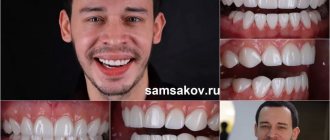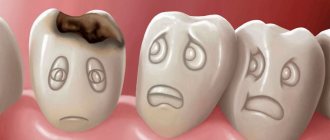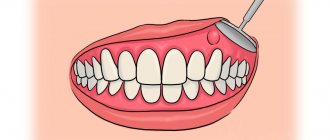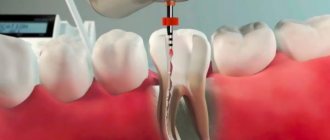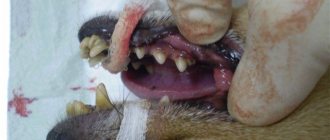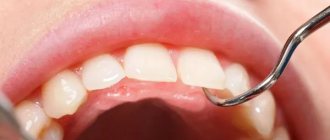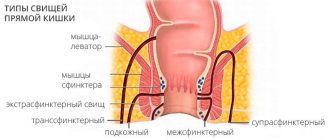- Author:
Naumovich Yulia Yakovlevna - Specialty:
Dentist-orthodontist - Category:
Doctor of the highest qualification category
Learn more about the doctor Get a consultation
Medium caries is one of the most common dental pathologies, which is characterized by destruction of tooth enamel, partial softening of dentin with subsequent loss of functions. Medium caries is extremely rare on baby teeth; more often it affects patients in adulthood.
The disease is an intermediate stage between superficial and deep caries. With it, a cone-shaped carious cavity is formed with the base tending to the surface of the tooth. In case of average caries, three layers of dentin softening are distinguished:
- softened with a seriously damaged structure;
- transparent (calcified, demyelinated);
- replacement (secondary), which performs a compensatory function, providing the tooth with protection from the development of further carious process.
The following types of average caries are distinguished depending on location:
- contact;
- fissure;
- cervical.
Average dental caries: what is it?
In total, experts distinguish four stages of the disease: initial, superficial, intermediate (dentine caries), deep caries. Each stage is characterized by its own depth of damage. For example, one cannot say that a person has superficial average caries, since this would be a gross mistake in terms of classifying the disease. On the other hand, if left untreated, a milder stage will at some point turn into a more severe one. If during superficial caries only the enamel structure is destroyed, then medium caries affects the dentin layer.
Medium and deep caries differ in that at the stage of deep damage the inflammatory process affects the dental pulp. The middle stage is not the easiest. However, it has more pronounced (compared to superficial and initial) symptoms, is quite easily diagnosed, and with timely dental care, the patient in the vast majority of cases can avoid serious consequences and save the tooth and its pulp. Experts distinguish two types of average caries.
Types of average caries
✔
Chronic average caries.
It lasts a long time and may not have pronounced symptoms.
With this form, a fairly wide brown carious hollow with hard walls is formed. ✔
Acute medium caries.
A rapidly developing form in which a small hole with sharp and brittle edges appears, which is filled with loose dentin.
Symptoms of caries development
Caries has several striking manifestations. In the initial stages of the disease, the symptoms are almost invisible, they do not bother the patient or cause discomfort. Over time and the development of the disease, the manifestations worsen, the intensity of the symptoms increases, and additional external and internal signs appear, noticeable to the patient and the people around him.
The initial stage is a change in the color and structure of the tooth
A change in tooth color indicates the beginning of a pathological process. Caries in its initial form is characterized by almost imperceptible changes in the structure of the tooth surface - the appearance of lines, grooves, irregularities, roughness, as well as the appearance of white, yellowish or dark spots on the tooth enamel. A change in the color of dental tissues is a sign of demineralization of the enamel, that is, its gradual destruction; if the resulting stains are brown or black, the demineralization process has transferred to the dentin.
Cavity formation
The formation of cavities or as we call holes in the dental tissue is the main sign of caries. In the initial stages of the formation of the disease, the cavities are hardly noticeable and cause almost no inconvenience. As caries progresses, cavities can be easily felt with the tongue and change color. Also, the resulting cavities are sensitive to temperature changes. In some cases, at this stage of the disease, patients are often bothered by aching toothache.
Dentin damage
If you continue to ignore the presence of cavities and discoloration, tooth decay moves to the next stage of development - attacking the dentin. It is impossible to detect this symptom on your own. The process of damage and softening of dentin can only be monitored during dental probing. The study shows a change in the structure of the tooth surface, the presence of irregularities and roughness, and softening of dentin. It is important that in case of carious disease, diagnostic probing is painful for the patient.
Increased tooth sensitivity
One of the most striking manifestations of caries is increased sensitivity of teeth to temperature and taste of food. Damage to tooth enamel causes a sharp reaction to cold, hot food and drinks, and is also expressed by acute pain when eating sugary foods. The severity of the symptom varies, depending on the level of damage to tooth enamel and the degree of development of carious disease. Sometimes tooth sensitivity occurs not only during eating, but also during changes in ambient temperature. With progressive caries, the affected tooth may react with pain when moving from a warm room to the street and back. Brushing your teeth with a regular toothbrush can also cause discomfort and pain.
Uncomfortable sensations while eating food
In addition to the increased sensitivity of teeth to the temperature of food, with caries the very process of chewing food causes discomfort or pain. The patient has the impression that the tooth is pierced by pain to the very root; the pain can be described as sharp, sharp, strong, even unbearable. However, when the stimulus disappears, it goes away quite quickly on its own.
Toothache
The development of caries can cause spontaneous toothache of various types (from mild aching to severe acute) for no apparent reason. Painful sensations occur suddenly, at any time of the day, regardless of food intake and activity. In this case, toothache is easily relieved with a painkiller or goes away on its own after a while.
Having bad breath
Bad breath is a constant companion for patients suffering from dental caries. The nature and intensity of the smell can be different and completely depend on the amount and degree of damage to dental caries. It is noteworthy that in the vast majority of cases the patient himself does not feel the unpleasant odor.
If you are concerned about at least one of the listed symptoms, call us at 8 (495) 033-00-63 or leave your information in the recording form. The Dentistry clinic on Shchelkovskaya “Diamed” is attended by a team of highly qualified specialists. We use modern methods of pain relief with insulin syringes, work with current filling materials, and provide a guarantee for the work performed. Make an appointment with the dentist now, don’t wait until caries reaches an acute stage and causes excruciating toothache!
Symptoms of average caries
In dentistry, there are cases when average caries does not manifest itself at all (especially in chronic form) or the patient simply does not notice the discomfort. However, more often the opposite happens. At this stage, more than one third of the dentin is affected, so the patient begins to feel the manifestations of the disease.
Complaints with average caries
- mild aching pain (may be absent)
- reaction to stimuli (chemical, temperature)
- discomfort when chewing, feeling of teeth on edge
- tooth color change
What do we offer?
Surely after reading this article you will be interested in the price of our services. With full responsibility, we can assure you that the cost of care in our clinic will convince you that professionalism, quality and individual approach to the patient do not depend on market trends.
Remember, health is priceless! Just call and we will help you save money and keep your teeth beautiful!
Date of publication: September 20, 2020 Last update: September 22, 2022 © 2020 Professorial Dentistry “22 Century”. All rights reserved.
Diagnosis of average caries
Many patients mistakenly think that if the carious cavity is small in diameter, then the disease is in the initial stage. In fact, even a tiny carious point in depth can extend all the way to the pulp. If we are talking about average caries, the patient’s complaints of severe pain, as a rule, are absent, but in order to finally make a diagnosis, a number of diagnostic procedures must be carried out. Below are the most common methods.
- Probing
is the easiest way to diagnose. Using a dental probe, the doctor probes the carious cavity, determines its depth and monitors the patient’s pain response. - X-ray
- using an X-ray or a visiograph, the doctor takes a picture in which the carious lesions and their depth are clearly visible. - EOD (electroodontodiagnosis)
- exposure to electric current. EDI for moderate caries is carried out quite often and is one of the types of differential diagnosis. Electroodontodiagnostics allows you to assess the depth of carious lesions and pulp viability. The absence of an inflammatory process in the pulp is what distinguishes medium caries from deep caries.
Etiology of acute and chronic caries
Dental caries is not an independent disease. Speaking about the factors that provoke their development, experts mention the state of the body as a whole, gastrointestinal diseases, general and local immunity, diet (amount of carbohydrates consumed)... But that’s not all - the following also play a role:
- Microflora of the oral cavity;
- Intensity and quality of salivation;
- The amount of fluoride that enters the body;
- Environmental component.
At the same time, the main factors for the development of caries remain unchanged:
- Susceptibility of the tooth surface to acids;
- Presence of cariogenic microorganisms in the oral cavity;
- The presence of microorganisms in the oral cavity that prevent the development of caries;
- Regularity and quality of hygiene measures.
Today, there are more than 400 theories about the causes of caries... But almost all of them are based on the fact that its occurrence is provoked by excessive accumulations of dental plaque. It occurs due to poor and irregular oral hygiene, especially in the fissures and on the lateral surfaces of the teeth. In these areas, it is not naturally removed by chewing and is difficult to remove during brushing due to poor access. In itself, it is an ideal environment for the development of pathogenic (in particular, streptococcal flora). As a result, it sticks to the tooth surface and becomes compacted due to the action of mineral salts contained in saliva, and then dental plaque is formed.
The bacteria that live in it produce lactic acid, under the influence of which the enamel loses salts and minerals (the process of demineralization). This is the first stage of the development of the disease. Another initiating factor for demineralization is a branched glucose polymer, which streptococci produce from sucrose. It is for this reason that the development of pathological processes is associated with the consumption of foods containing simple carbohydrates.
The rate of development of acute caries is determined by the individual characteristics of the body. In most cases, the ability to resist cariogenic bacteria is low, so the pathological process develops quickly. However, if immunity is high enough and there are no concomitant pathologies, the process slows down. The composition of saliva also plays a role: if the ratio of mineral salts in it is disturbed, the risk and rate of development of carious processes is higher due to the deterioration of its antibacterial characteristics. Don’t forget about the environmental component and the quality of drinking water, because they also affect overall immunity.
Treatment of average caries
The stage of average caries in most cases does not imply conservative treatment without the use of a drill. Therefore, almost all treatment methods for moderate caries involve the installation of a filling. Moreover, if the stage is on the verge of deep, the doctor may even advise depulpation and canal filling. In this case, the treatment of medium and deep caries is almost the same. Fortunately, such situations are quite rare. Treatment of average caries occurs in stages and usually takes one visit to the doctor.
6 stages of treatment for average caries
- initial examination, diagnostic procedures;
- anesthesia;
- removal of tissues affected by caries, formation of a cavity for filling;
- medicinal treatment and surface drying;
- installation of a seal;
- the final stage of polishing the filling.
Medium caries on the front teeth is more difficult to treat, since the issue of aesthetics is of great importance here. Typically, more expensive photopolymer and compomer fillings are installed in the frontal zone.
Seals
Dental treatment and installation of a filling in Korolev is a labor-intensive process that requires high professionalism from the doctor so that it does not fall out untimely or break. In addition, the material from which the filling is made also affects the quality of treatment and the health of the tooth in general.
Fillings are needed for the treatment of caries, dental canals, wedge-shaped defects, as well as for the aesthetic restoration of damaged teeth.
A filling is a plastic and viscous medical material that gradually hardens in the tooth cavity on its own or under the influence of external factors. In our dentistry in Korolev, dental therapists use reflective fillings made from insoluble, safe and resistant materials that meet established hygienic standards.
Thanks to light fillings, restoration and treatment of anterior teeth can be carried out without difficulty. With this material you can easily and quickly sculpt a beautiful and correct shape, fixing the result with ultraviolet radiation.
Prevention of secondary caries
The occurrence of carious lesions indicates the activity of pathogenic microorganisms that destroy the protective layer of enamel and tooth tissue. Predisposition to the disease may be genetic, but to a greater extent this dental disease is associated with hygiene and/or nutrition. Moderate caries is considered a developed stage of the disease: often many patients, having noticed a carious stain, think that it will “resolve” by itself, and consult a doctor only when they feel pain and discomfort. The main goal of prevention is to prevent the development of the disease and its transition to the middle and deep stages, when it is no longer possible to do without a drill. The key to success here is simple: regular and high-quality hygiene, proper nutrition and preventive visits to the doctor. If you follow at least these points, then the chance of developing the disease will be minimal.
Measures to prevent dental caries
The following preventive measures will help to avoid damage to the integrity of tooth enamel and damage to dentin:
- Regular (twice a year) visits to the dentist for a preventive examination.
- Thorough regular cleaning of teeth, interdental spaces, tongue using a toothbrush, paste, floss, and, if possible, an irrigator.
- Drinking drinking water rich in fluoride and other beneficial elements.
- Preventive intake of vitamin complexes as recommended by the dentist.
Prevention reduces the risk of dental caries and other dental diseases by more than 70%.
Visualization and Percussion
Dental treatment offered by dental clinics in St. Petersburg, regardless of the protocol, requires a mandatory preliminary examination of the oral cavity and dentition. The doctor conducting the visual examination has the skills to confirm or refute the presence of pathological changes. The characteristic signs of caries are associated with the structure of the enamel layer - the integrity of the coating is damaged, pigment spots are formed, etc.
The instruments used at this stage are limited to a dental mirror and probe. At the same time, it should be noted that the technique is superficial and does not allow one to form a clear idea of the stage of development of the pathology. Percussion - tapping the crowns with a steel instrument, accompanied by recording complaints of pain or discomfort in certain areas - also allows us to clarify the extent of the spread of caries.
Initial caries is caries in the spot stage.
The surface of the enamel, its structure, has already been damaged, but there is no cavity in the tooth yet. When treating such caries, the tooth is not prepared and a filling is not installed. If caries is detected at this stage, the process can be reversible. The goal of treating this type of caries is to restore the enamel structure and replenish lost microelements, such as calcium and fluoride. To do this, they use remineralizing therapy with professional means in the clinic, and also prescribe independent home procedures using special products. If you follow the recommendations of the attending physician, the tooth structure is restored overnight and further treatment of caries is not required. The cost of treating such caries on average ranges from 100 to 500 rubles.
Basic approaches
The key factors that determine the complexity of diagnosing and treating carious diseases are the localization and extent of spread of the pathology. The choice of clinical examination technique for the oral cavity is based on these indicators.
A characteristic sign of the presence of caries in the initial stages of development is the presence of a small chalky spot, which gradually turns into a black dot. It is extremely difficult to assess the scale of the problem by simple visual inspection, since the process takes place inside the dentin. Situations often arise when the patient does not experience pain until the very end. The pathology occurs in a latent mode, and only damage to the pulp becomes a reason to consult a doctor. As a rule, the degree of destruction leaves no other option but to remove the nerve.
Timely detection of caries is directly related to periodic visual examination of the condition of the dentition, which can be carried out by both the doctor and the patient himself. The advanced form is characterized not only by pain, which intensifies with mechanical pressure on the affected area, but also by the formation of large cavities under the enamel, the blackness of which is noticeable under the protective layer of the tooth.
Modern techniques
Prices for dental treatment consist of many factors, including the cost of using special equipment, manufacturing prosthetic structures, filling materials, etc. Timely routine diagnostics allow you to save on caries treatment, allowing you to localize the pathology at an early stage of development. Popular techniques recommended by dentists include:
- Probing is a gentle contact-type technique that allows you to determine the presence of defects in tooth enamel, evaluate the smoothness of the coating, as well as the degree of sensitivity to external irritants;
- Vital staining is a diagnosis using color markers that highlight areas where caries develops. The coloring composition is applied to the surface of the dentition - areas suffering from insufficient mineral structure attract pigment, which makes it possible to identify areas that require detailed examination;
- X-ray examination is a standard procedure, the principle of which every high school student knows about. The use of X-rays facilitates the formation of a clinical picture, especially in situations where the source of pathology is located in hard-to-reach areas of the dentition, or is hidden in the depths of the crown, under an installed filling;
- Thermal test is an unpopular technique associated with discomfort and pain experienced by the patient. To identify the reaction, systematic heating of dental tissue is used, provoking the occurrence of pain in the presence of hidden deviations;
- Electroodontometry is a diagnostic method recommended for identifying carious formations in pulpitis. The examination technology involves applying an electric discharge to individual elements of the dentition, which allows one to assess the degree of the patient’s reaction;
Luminescent illumination. A rather complex technique - the dentition is illuminated with light devices emitting cold spectrum waves. Areas of dental tissue affected by caries are highlighted in a dark color.
Pain and other complications after treatment
Complications are possible, but rare, as a competent dentist will try to avoid them. The doctor will also warn that slight soreness appears after the anesthesia wears off and may last for 2 to 3 days. If the pain does not increase, but, on the contrary, decreases in intensity, then this is normal.
You need to see a doctor urgently if:
- there was severe increasing pain;
- the pain intensified, the cheek became swollen;
- headache appears, fever or low temperature lasts more than two days.
